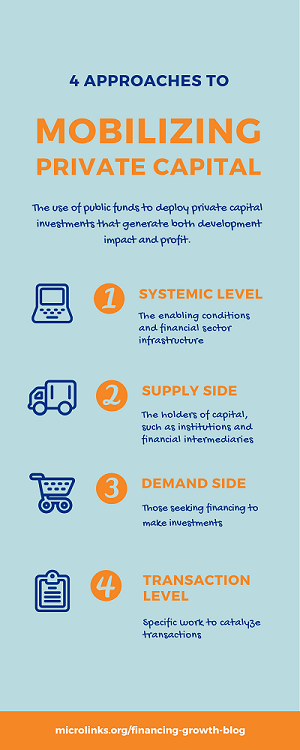Getting Outfitted at the General Store: Introducing the Mobilizing Private Capital Lexicon

For a period of fifty years beginning in the 1830s, pioneers reached the fertile, green lands of California and the Colombia Valley by wagon train. Each spring, settlers would gather with their Conestoga wagons in the towns near Independence, Missouri, where they would form groups and hire wagon masters to lead them on the journey west. The trip was long, dusty, and dry – but for most, well worth it.
Well, here we are: pioneers (of a sort), camped by the Missouri River, wagons loaded, and ready to head out on the trail. As your wagon master, my job is to get you across the prairie and over the Rockies. I am tasked with bringing you safely to the promised land of understanding how to engage “private capital” in accomplishing development objectives (in a way that is also “inclusive”). We will face many perils on this journey, but my hope is not to lose too many of you along the way. So let's make sure we are properly outfitted with the right terminology before we head out on the trail.
The term “private capital” as we use it here in the wagon train is quite broad – it means every dollar available for investment that does not come from government or donor hands. This covers the spectrum from private equity dollars (capital that is privately invested and not subject to regulation) to Tanzanian shillings saved in the mattress for the purchase of a walking tractor. It includes funds held in financial institutions and by institutional investors (pension funds and insurance companies) available for loans and equity investments, as well as company stock and retained earnings by businesses. Private capital expects a financial return that is commensurate with the risk taken.
By “inclusive,” we mean a somewhat broad distribution of benefits resulting from the investment of capital. Again, all capital requires and deserves an adequate return when it is loaned or invested. But if we, as the development community, support the capital to be invested, we expect it to benefit our development goals in some way. Commercial objectives and development objectives can be aligned.
By “mobilizing,” we mean doing something to deploy private capital (put to work in the form of a capital expenditure, a loan, or an equity participation) which otherwise would not have occurred. Our efforts should only mobilize additional private capital. (There’s no point in spending our money on something that was going to happen anyway!)
Your wagon master sees four main intervention points at which the mobilization of private capital can be facilitated:
capital can be facilitated:
- at the systemic level (the enabling conditions and financial sector infrastructure that support financial intermediation);
- on the supply side (working with the holders of capital, such as institutions and financial intermediaries);
- on the demand side (working with those seeking financing to make investments); and
- on the transaction level (working specifically to catalyze transactions).
During our journey, we will explore these different intervention points using the concrete case studies that you have contributed. As we continue on, we would love to hear your thoughts, comments, and questions. We would also suggest that you keep the following in mind:
- What was the bang for the buck? How much private capital was mobilized and at what cost?
- How effective was the initiative in supporting development objectives, and how broadly were benefits distributed (i.e. was it “inclusive”)?
- Was the intervention “additional”? In other words, was our intervention really needed, or would it have happened anyway?
And with that in mind, mount your wagons, and “Wagons Ho”!
Our first vignette on the journey demonstrates how we have catalyzed private financing through the provision of technical assistance and pay-for-performance incentives.
Khan Bank Mongolia: Turn-Around and Privatization of State-Owned Khan Bank
The challenge: Keeping a failing state-owned agricultural development bank in business so that it could continue to serve rural populations of Mongolia.
The solution: In 2002, USAID contracted DAI through a $2 million award to assume management of Khan Bank and prepare for its sale. DAI brought in a professional team and totally transformed the bank, including new policies and procedures, development and retraining of staff, rebranding and marketing, new product development, and inculcation of new values and behavior. Since 2003, the now private Khan Bank has been one of the two largest banks in the country, and, today, it boasts the highest profitability and return on assets. Khan Bank has evolved into a full service universal bank with total assets of $2.7 billion and a network of 536 branches with over 5000 employees.
How it mobilized private capital: The $2 million USAID investment to transform Khan Bank has had spectacular impact in mobilizing private capital. Equity has increased from $6.5 million to $333 million today, and loans outstanding (effectively private capital mobilized and put to work in the form of credit) rose from $67 million in 2004 to $1.6 billion today.
How it was inclusive: Khan maintained and expanded its rural presence: over 60% of Mongolians have an account at the bank, giving them access to credit and a full range of other banking services.
How it was innovative: Khan Bank was innovative in two ways. First, rather than providing advisory services or training, USAID’s contractor was given management control by the Government of Mongolia and brought in the expertise needed to turn it around. The second innovative element that contributed to the successful turnaround was a performance-based incentive provided to DAI. After the conclusion of USAID engagement, Khan Bank’s owners hired DAI directly and provided it with attractive stock options based on performance targets.
Lessons learned: The bold step of taking control of Khan Bank yielded spectacular results which would not have been achieved had only advisory support been provided. Performance-based incentives worked. Investing in the capacity of a host country financial intermediary paid big returns.
This vignette was submitted by DAI's Robert Dressen (robert_dressen@dai.com), Senior Banking & Financial Services Advisor, with support from John Jepsen (john_jepsen@dai.com), Global Practice Leader for Financial Services.


